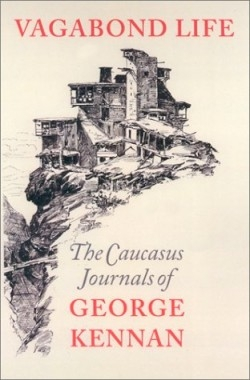Vagabond Life
The Caucasus Journals of George Kennan
“ … I traveled through the Caucasus like a perfect vagabond,“ wrote Kennan, noting he one day journeyed with a prince, the next with a pauper … one day dined in state, the next subsisted on raw turnips.
At twelve Kennan was a telegraphist, at twenty he was working in Siberia for the Russian-American Telegraph Co., at twenty-five he saw his Tent Life in Siberia becoming an adventure and ethnographic classic. Thereafter politics or war took him to Cuba, Japan, Manchuria, and Russia. Lectures, books, and pundit status followed. Regrettably, Kennan, did not write a book on his Russian and Caucasian travels of 1870, his twenty-fifth year. Now, thanks to the highly skilled editorial work of Maier (herself a published traveler) his travel-journals have emerged as Vagabond Days.
Kennan, a well-read Russian speaker, provides a perceptive description of his exhausting voyage down the Volga from Nizhnii Novgorod to Astrakan and on through the Caspian to the Caucasus. Once on land, he recorded his incident-filled journeys southwest to Tbilisi, north up the Georgian Military Highway, through the main Caucasus range (with its 18,000 ft. peaks) to Vladikavkaz and Grozny. He then explored Muslim Chechnya and Dagestan before re-crossing the Caucasus and traveling southwest through Georgia to his Black Sea exit port of Poti.
He had the luck to travel part way with Prince Jorjadze, a Christian Georgian serving the Russians as an administrator. Thanks to Jorjadze, Kennan experienced traditional Muslim hospitality and saw both formal shariat and folk-sanctioned adat justice in operation. Well aware of the exotic, near-oriental mystery of the region, he missed no human-interest detail: beyond “gratification of [his] own curiosity”: he had lecture hall audiences in mind.
Kennan describes a multiethnic region of Chechens, Avars, Lezghians, Ossetians, Kabardians, Circassians, Kalmucks, Tatars, Georgians and other indigenous peoples, plus Russians, Persians, Turks, and Jews. The result was a proverbial “a mountain of languages” and of creed, costume, and custom. Color permeates the reportage: “Cossacks in black trimmed with red … Kalmucks in caps of white or black curly lambs’ wool … Persian women in long white veils … “ As for religious festivals, “ The Persians… begin dancing, shouting Sak-see Bak-see … slashing themselves over the head and breast … the blood runs down their naked bodies … they have nothing on but drawers … .”
Peaks and precipices, weapons and feuds, horses and falcons, Muslim bands and bazaars, Lezghian dinners and dances, and tales of lost Crusaders light up the narrative. Yet Kennan never forgoes serious ethnographic-anthropological note-taking or overlooks economic and social factors. Nor does he forget that the Caucasian region was still smarting from the brutal yet incomplete Russian conquest of 1820 to 1859, in which the heroic defender, Imam Shamil, won fame.
As editor, Maier has provided a first-rate Introduction, footnotes, and bibliography. She places Kennan and his life in context; analyzes contemporary perceptions of life in the Caucasus; and sets the historical scene, discussing Russian intervention in the region and also the explosive impact the Caucasus had on Russian literature. Her analyses of Kennan’s “take” on the Caucasus and on Russia (in which enthusiasm occasionally overcame objectivity) and of American attitudes to the Tsar’s policies are judicious.
Vagabond Life is a rare delight; a beautifully produced, well-illustrated scholarly contribution that also succeeds effortlessly as a remarkable account of exploration, adventure, and exotic life. Washington University Press and Maier deserve congratulations. The book is the more valuable because most classics of Caucasian history and travel—those of Baddeley, Bell, Cunynghame, Ditson, Dumas, Freshfield, Klaproth, Nansen, and Telfer among them—are long out of print, though highly deserving of re-issue.
Oxford University Press is showing commendable initiative in re-issuing A Ride to Khiva and On Horseback Through Asia Minor (Frederick Burnaby’s 1870s true-adventure narratives, replete with local color and anti-Russian reportage), together with Hunted Through Central Asia (Paul Nazaroff) and Mission to Tashkent (Frederick Bailey), in which wily Western agents bedevil blundering Bolsheviks during the Russian Civil War. Publishers take note: there’s more to be done!
Disclosure: This article is not an endorsement, but a review. The publisher of this book provided free copies of the book to have their book reviewed by a professional reviewer. No fee was paid by the publisher for this review. Foreword Reviews only recommends books that we love. Foreword Magazine, Inc. is disclosing this in accordance with the Federal Trade Commission’s 16 CFR, Part 255.

